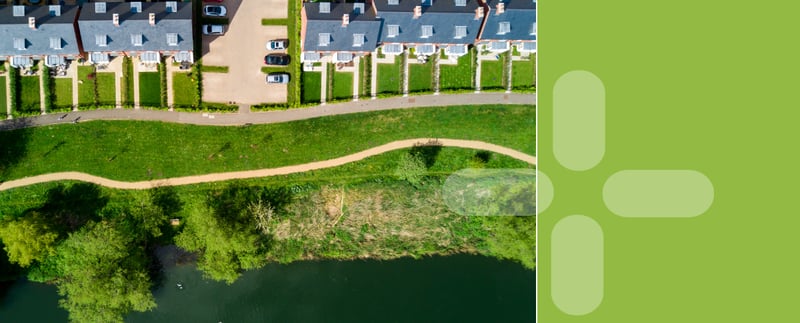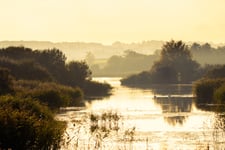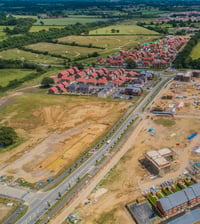To meet the minimum requirement of 10% biodiversity net gain (BNG), that becomes mandatory for larger sites in England in February 2024, developers face a critical choice between investing in onsite or offsite BNG projects.
This blog explores the benefits of each approach to help housing developers make informed decisions within their BNG plan.
What is onsite biodiversity net gain?
Onsite biodiversity net gain refers to habitat creation projects conducted within the development site itself. Examples include:
- Creating wildlife-friendly gardens with native plants and pollinator-friendly vegetation
- Constructing ponds or wetland areas to support aquatic species
- Setting aside green corridors or buffer zones to preserve existing habitats or create new ones
Read more examples of how developments can be made more nature-friendly here.

There are several advantages to investing in onsite BNG:
- Direct Impact Mitigation
Onsite biodiversity net gain projects allow developers to directly address the ecological consequences of their building work. This means that any impacts on local biodiversity can be mitigated in close proximity to the development, ensuring the preservation of potentially rare ecosystems.
- Stakeholder engagement
Onsite BNG projects provide a brilliant opportunity for developers to engage with the local community and visually showcase their commitment to sustainability. These projects can become educational resources, fostering a sense of environmental responsibility among residents.
- Cost savings
In some cases, achieving BNG onsite can be more cost-effective than offsite alternatives. It reduces the logistical complexity of managing a habitat creation project in a separate location, or potentially having to engage a third party, benefitting operational efficiencies and possibly saving developers money in the long run.
- Enhanced living space
By integrating biodiversity into the development site itself, developers can create a harmonious and attractive living environment. This approach can enhance property values and attract eco-conscious buyers.
What is offsite biodiversity net gain?
Offsite biodiversity offsetting, on the other hand, involves investing in conservation or restoration efforts in a different location, ideally in the same local area or an area of similar ecological characteristics. This could take the form of:
- Woodland restoration in a nearby nature reserve, helping to conserve native tree species and maintain wildlife habitats

- Wetland creation in a vulnerable ecosystem, such as degraded marshland or an estuary, that could help protect water quality and flood management
Here are the advantages of supporting offsite BNG schemes:
- Landscape level impact
Offsite BNG projects can have a broader environmental benefit by addressing conservation needs in areas where biodiversity is particularly vulnerable. This approach can contribute to the overall resilience of regional ecosystems, demonstrating a developer’s corporate commitment to wider nature protection.
- Expertise and management
Offsite BNG projects are often managed by conservation experts with local knowledge who can ensure that the project's ecological goals are met effectively. Developers can rely on their experience and expertise.
- Flexibility and options
Investing in BNG offsite can provide developers with more flexibility to choose from a range of habitat creation projects and locations that best match the ecological requirements of the development. This can lead to better outcomes for biodiversity.
- Compliance with local planning authorities
Despite 10% BNG regulations becoming live across England in February 2024 for larger scale developers, regional planning authorities will differ in how they put this into practice - according to factors such as the level of development pressure and habitat sensitivity. In some cases, local regulations or planning requirements may favour offsite BNG schemes as a means to achieve biodiversity conservation goals more effectively.
Making a decision on onsite vs offsite BNG
 While both onsite and offsite biodiversity schemes have their advantages, the choice between the two is not always straightforward.
While both onsite and offsite biodiversity schemes have their advantages, the choice between the two is not always straightforward.
In many cases, the most effective approach may involve a combination of both, ensuring that development projects address local impacts directly AND contribute to broader conservation efforts.
Developers must consider various factors when deciding between onsite and offsite biodiversity offsetting:
- Site-specific Considerations: The characteristics of the development site, including its existing biodiversity, size, and location, will heavily influence the choice of offsetting approach.
- Legal and regulatory requirements: Developers must comply with local and national regulations, which may dictate the preferred offsetting method or require a certain level of biodiversity restoration.
- Cost Analysis: A thorough cost-benefit analysis is crucial. Onsite offsetting may be cheaper in some cases, but offsite projects may offer long-term ecological benefits that outweigh initial costs.
- Community Engagement: Developers should assess the preferences and concerns of local communities, as public support can play a significant role in project approval.
Learn more – read an expert’s overview of essential BNG considerations for developers from Paul Brown, Head of Remote Sensing, GIS and Spatial Data Science at Fera.
A balanced approach to securing BNG
The choice between onsite and BNG projects for housing developers in England is not a one-size-fits-all decision. It requires detailed analysis and planning, which scientists such as those in Fera’s LAND360 team can support with.
Both approaches have their merits, and the best choice depends on the unique circumstances of each development.
An in-depth biodiversity assessment, which can be carried out by one of the LAND360 ecologists, will help with the collation of extensive land-based data for the specified development site – a crucial starting point for a bespoke BNG plan.
Ultimately, taking a holistic approach to delivering BNG, considering the ecological impact, cost, and regulatory requirements for each particular site will help developers strike a balance between urban growth and environmental conservation.
 "BNG is fast approaching so there has never been a more important time for developers to map and benchmark site biodiversity"
"BNG is fast approaching so there has never been a more important time for developers to map and benchmark site biodiversity"
- Paul Brown, Senior GI Remote Sensing Specialist, Fera Science
More about LAND360
LAND360 is Fera's cutting-edge natural capital assessment service. Launched in 2022, it empowers farmers, landowners, estate managers, and housing developers to make informed land use decisions. By accurately measuring and mapping existing land habitat features and modelling biodiversity offerings, LAND360 is a vital tool in the quest for sustainable development and biodiversity enhancement.
